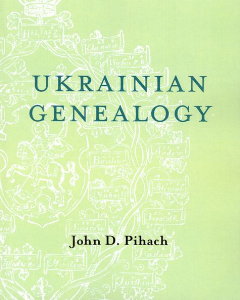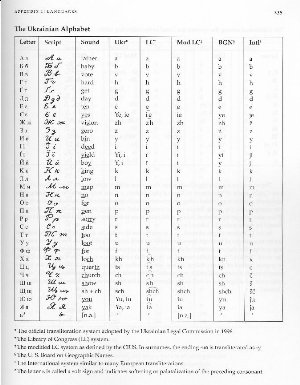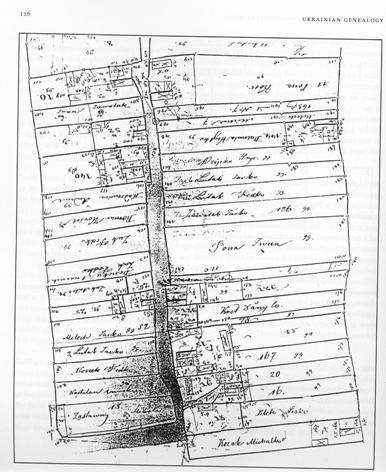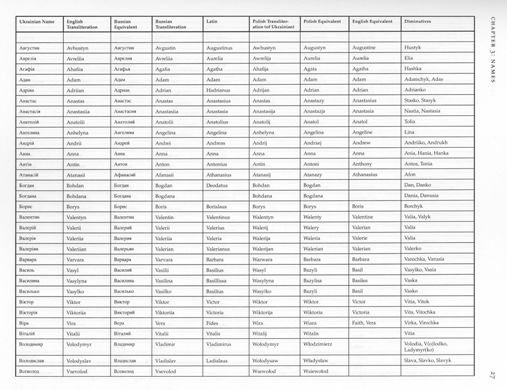Exciting New Publication: Ukrainian
Genealogy
by John D. Pihach

Canadian Institute of Ukrainian Studies Press, copyright
©2007
ISBN 1-894865-04-9 (bound); ISBN 1-894865-05-7 (paperback)
272 pages, about $34.95
Available through the internet:
http://www.amazon.com
http://www.utoronto.ca/cius/publications/books/ukrainiangenealogy.htm
John D. Pihach’s book Ukrainian Genealogy is the most
comprehensive and important book for Ukrainian genealogists available.
Pihach has successfully reined in the many aspects of Ukrainian genealogy into
one text. For the novice genealogist, he introduces the subject by
providing a background on the history of Ukraine and Ukrainian immigration to
North America. He further covers the complex issue of language by
presenting a detailed, yet easy to read, account of Ukrainian given names and
surnames, as well as language usage as found in various documents important to
the genealogist. Although the book is subtitled “A Beginner’s Guide”,
Pihach provides an exhaustive study of maps, cadastral documents and a vast
collection of footnotes and citations that are sure to entice the experienced
researcher. The logical layout of the book allows it to serve as a trusty
reference to be returned to time and time again.
Pihach explains that the book is “a guide to tracing one’s
Ukrainian ancestry in Europe. It is not a guide for those wishing to trace
their roots on this continent…Consideration, however, is given here to those
North American records that are specifically Ukrainian or relate to the
immigrant experience”. Pihach presents North American records only in
relation to Ukrainian research in Europe or to determine one’s ancestral
village. This covers passenger lists, immigration records, naturalization
and citizenship records, census, homestead and land records, etc.
Pihach’s must read book is broken down into 12 chapters, 3
appendices, and an impressive bibliography. The first two chapters are an
introduction to Ukrainian genealogy. They deal with starting your
research, both in general genealogical practices as well as specific to
Ukrainian research. Pihach provides a brief history of Ukraine and of
Ukrainian immigration to North America. Furthermore, a history and
background of Ukrainian church records in Canada and the US can be found in
chapters 4 and 5. Due to a colorful past and complex terminology, the
subject of Ukrainian national, immigration and church history is not as easy as
one might think. Yet Pihach successfully gives the reader an excellent
overview, which serves the genealogist to better understand his/her own rich
national heritage, as well as to provide direction in terms of finding and
interpreting vital records and various other important resources.
An entire chapter is devoted to the singular, most
important task of the Ukrainian genealogist, that of locating the ancestral
home. Pihach, due to Ukraine’s rich history, must illustrate research
methodologies covering several countries and time periods: The Russian and
Austro-Hungarian Empires, as well as Poland, Hungary, Romania and the USSR.
Pihach goes into great detail explaining the geographic breakdown of the various
countries and time periods necessary to assist the researcher.
Furthermore, Pihach describes the array of invaluable gazetteers available.
 Several
chapters of Pihach’s book are dedicated to vital records, the basis of most
family research. The book covers all the necessary aspects of vital
records. Pihach explains record keeping practices across national borders
and time periods. Furthermore, he explains the various availability and
location of records. Pihach has personally visited archives all across
Central and Eastern Europe. His intimate knowledge of the archives, as
well as their practices and catalogues, is a gift to all researchers.
Pihach includes a Ukrainian archive request letter writing guide and explains
the procedure for on-site archival visits in Ukraine. The author’s depth
of subject material is mind-boggling. In addition to writing about on-site
research, Pihach brings to light the availability of records and research
opportunities found on the internet. Pihach is completely abreast of the
most current information.
Several
chapters of Pihach’s book are dedicated to vital records, the basis of most
family research. The book covers all the necessary aspects of vital
records. Pihach explains record keeping practices across national borders
and time periods. Furthermore, he explains the various availability and
location of records. Pihach has personally visited archives all across
Central and Eastern Europe. His intimate knowledge of the archives, as
well as their practices and catalogues, is a gift to all researchers.
Pihach includes a Ukrainian archive request letter writing guide and explains
the procedure for on-site archival visits in Ukraine. The author’s depth
of subject material is mind-boggling. In addition to writing about on-site
research, Pihach brings to light the availability of records and research
opportunities found on the internet. Pihach is completely abreast of the
most current information.
Pihach details the various types of vital records, both
Greek Catholic and Orthodox, both Austro-Hungarian and Russian Empire, both
Roman and Cyrillic alphabets. Pihach takes us on an exciting tour of
records from the late 18th to the 20th centuries giving
great detail in explaining the documents and provides a number of illustrated
examples. He translates the documents section by section providing a short
selection of common terms found in different languages, covering Ukrainian,
Russian, Latin, Polish, German and Romanian…(who says Ukrainian research isn’t
fun?).
As every genealogist knows, there’s more to research than
vital records. Since the break-up of the Soviet Union and fall of
Communism in the early 1990’s, new documents have only recently become
available. One of the most important features of the book is the entire
chapter on Austrian land records. Pihach writes: “When Austria acquired
Galicia, in order to establish a reliable basis for land taxation the
authorities initiated land and tax reforms that required the measurement of all
land properties in the new crownland.” Pihach explains the 19th
Century documents which serve as a complete picture of a village, a snapshot in
time.
 Pihach
also writes about the many types of maps available for research. He
illustrates over a dozen of the most popular and informative maps by featuring
the village Chotyniec, located on the Polish-Ukrainian border. By using
the one village as an example, Pihach is able to go into great detail about each
of the map series. Included in the study is an in-depth discussion of the
cadastral maps and associated texts, an exciting feature of Austro-Hungarian
research. The maps and texts, created for taxation purposes and settling
property disputes, allow the researcher to reconstruct the ancestral community.
Pihach writes: “…literature about cadastral surveys and maps in English is
scarce”. Pihach fills the gap by bringing to light this incredible
resource.
Pihach
also writes about the many types of maps available for research. He
illustrates over a dozen of the most popular and informative maps by featuring
the village Chotyniec, located on the Polish-Ukrainian border. By using
the one village as an example, Pihach is able to go into great detail about each
of the map series. Included in the study is an in-depth discussion of the
cadastral maps and associated texts, an exciting feature of Austro-Hungarian
research. The maps and texts, created for taxation purposes and settling
property disputes, allow the researcher to reconstruct the ancestral community.
Pihach writes: “…literature about cadastral surveys and maps in English is
scarce”. Pihach fills the gap by bringing to light this incredible
resource.
 In
addition to a complete list of essential archive addresses (covering Canada, US,
Ukraine, Poland, Slovakia, Hungary, Russia and Romania), the book contains three
appendices. The first, “Languages”, covers several alphabets, including
Ukrainian and Russian (along with various transliteration systems), Church
Slavonic, Polish, German and Romanian. Examples of cursive writing are
also included to help with interpreting records. The second appendix gives
contact information on other ethnic groups located in Ukrainian territories,
such as Polish, Jewish, German, Mennonite, Rusyn (aka Carpatho-Rusyn), Czech,
Slovak and Russian groups. The last appendix lists useful web sites.
This last subject is a challenge for publications in print since web sites often
come and go. But Pihach careful chooses the most essential and informative
internet sites. Finally, an exhaustive bibliography, 12 pages worth, is
provided. The bibliography is broken down by category making it easy to
follow and reference. These last two sections are sure to keep the
genealogist busy…and well informed!
In
addition to a complete list of essential archive addresses (covering Canada, US,
Ukraine, Poland, Slovakia, Hungary, Russia and Romania), the book contains three
appendices. The first, “Languages”, covers several alphabets, including
Ukrainian and Russian (along with various transliteration systems), Church
Slavonic, Polish, German and Romanian. Examples of cursive writing are
also included to help with interpreting records. The second appendix gives
contact information on other ethnic groups located in Ukrainian territories,
such as Polish, Jewish, German, Mennonite, Rusyn (aka Carpatho-Rusyn), Czech,
Slovak and Russian groups. The last appendix lists useful web sites.
This last subject is a challenge for publications in print since web sites often
come and go. But Pihach careful chooses the most essential and informative
internet sites. Finally, an exhaustive bibliography, 12 pages worth, is
provided. The bibliography is broken down by category making it easy to
follow and reference. These last two sections are sure to keep the
genealogist busy…and well informed!
I strongly urge everyone researching, or on the verge of
starting to research, his/her Ukrainian roots to run, not walk, to get a copy of
this book! Pihach has managed to bring all components of Ukrainian
genealogical research into one book. I’m confident that every genealogist
will refer to this book over and over again.